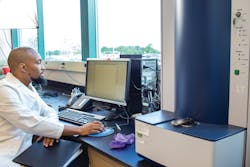Mass Spectrometry in the clinical lab – from drug detection to cancer proteomics
Mass spectrometers have been around for about 100 years. However, the use of mass spectrometers in the clinical laboratory did not first appear until the early 1970s. In the clinical laboratory, mass spectrometers were initially used to detect drugs of abuse, monitor therapeutic drug use, steroid analysis and newborn screening. More recently, mass spectrometers have been utilized for bacterial identification.1 Mass spectrometry made its move into the clinical laboratory due to its increased sensitivity and specificity; increased reproducibility; ability to detect multiple analytes in one run; decreased cost, time and sample volume requirements; and the discovery of novel or esoteric analytes.
Mass spectrometry in the clinical laboratory
Initially, mass spectrometry-based assays in the clinical laboratory focused on assays geared toward the identification of small molecules using a gas chromatography system coupled to a mass spectrometer (GC-MS). The instrument typically used for GC-MS analysis was a single quadrupole mass spectrometer paired with an in-line GC system. Single quadrupole mass spectrometers are relatively cheap and versatile for a variety of small, volatile, thermally stable, nonpolar molecules.
The most common type of ionization method used in GC-MS is electron ionization (EI). Ionization by EI occurs via an electron ejection from the interaction of the analyte with a high-energy electron beam. Due to the high energy needed for EI, the molecules fragment upon ionization, and it is these fragments generated from the ionization process that are detected by the mass spectrometer. Common analytes identified by GC-MS in a clinical laboratory include drugs of abuse, therapeutic drugs and steroids. Larger analytes, generally greater than 500Da, are not candidates for GC-MS due to their incompatibility with the methodology.
Due to the limited utility of GC-MS in analyzing only small, volatile, thermally stable, nonpolar molecules, other ionization techniques were investigated. In the 1980s electrospray ionization (ESI) was introduced, which permitted the coupling of a liquid chromatography system to a mass spectrometer (LC-MS). This soft ionization technique left the analyte intact upon ionization. Coupling both LC and ESI allowed for the analysis of a greater variety of analytes to include larger, polar, nonvolatile and thermally labile molecules, including proteins.2
The increased utility of coupling LC to an ESI or atmospheric pressure chemical ionization (APCI) ionization source allowed LC-MS-based methodologies to become more prominent in the clinical laboratory, allowing for the analysis of both small and large molecules of either polarity in a complex biological sample.2 As with ESI- or APCI-based LC-MS methods and the lack of need for analyte volatility and thermal stability, the methodology opened up a wider range of clinical testing that can be performed using a mass spectrometer.
LC-based methodologies tend to utilize reverse phase-high pressure LC (RP-HPLC) paired with a triple quadrupole mass spectrometer that typically adopts the multiple reaction monitoring (MRM) analysis method. In using MRM, the mass (or more specifically the mass-to-charge ratio [m/z]) of the analyte of interest is selected by the first quadrupole. The second “quadrupole” is used as a collision chamber where the analyte molecule is bombarded with helium gas causing the molecule to fragment into several pieces.
The last quadrupole of the triple quadrupole is responsible for selecting the m/z of one of these fragment ions for detection and quantitation. This type of mass spectrometry approach, called tandem MS (or MS/MS), increases sensitivity as well as specificity, and allows for accurate quantitation when the appropriate internal standards are utilized.2 However, due to the technical nature and operator expertise required of GC-MS, as well as LC-MS-based methodologies, laboratory tests based on these methods are typically laboratory-developed tests.
This technology also leads to the switch from traditional immunoassay-based tests to a mass spectrometry-based methodology due to the increased specificity and sensitivity of the mass spectrometry methodology. Traditional immunoassay-based tests for vitamin D typically measure total 25-hydroxyvitamin D (25OHVitD). However, mass spectrometry-based methodologies can differentiate between 25OHVitD2 and 25OHVitD3, which is useful for monitoring supplemented vitamin D levels.
Challenges facing immunoassays include generating specific antibodies due to the structural similarity of 25OHVitD2 and 25OHVitD3. Vitamin D immunoassays are also prone to metabolite cross reactivity and matrix effects. Immunoassays have sufficient accuracy and precision for measuring total testosterone in males (both normal and abnormal). However, this is not the case when it comes to females and pediatric samples due to the low concentrations normally found in these patients, whereas mass spectrometry can attain the sensitivity needed in these populations.
Bacterial identification by mass spectrometry uses an entirely different class of mass spectrometry-based methodology. The matrix-assisted laser desorption ionization-time of flight (MALDI-TOF) mass spectrometer generates an m/z spectrum profile derived from bacterial proteins. MALDI is an ionization technique that uses a nitrogen laser to vaporize and ionize samples spotted onto a stainless-steel plate.
Ionization occurs via photon absorption and proton transfer leaving the molecule intact. Bacterial identification by MADI-TOF is currently the only FDA-approved clinical mass spectrometry based diagnostic test (Class II medical device). Once the samples are spotted on the steel plate, it takes only a few minutes to analyze 96 samples. Utilizing the MALDI-TOF bacterial identification system, the bacterial protein m/z profile (or fingerprint) is compared to either a commercially available library for FDA-approved instruments or an in-house library. Figure 1 shows a MALDI-TOF instrument in use for bacterial identification.
The MALDI-TOF bacterial identification method can be of particular benefit when trying to identify anaerobic, fastidious or slow-growing bacteria where traditional anaerobe identification methods can be time-consuming, difficult to identify and costly. In a meta-analysis conducted by Li et al., 28 studies covering 6,685 strains of anaerobic bacteria were used to determine the identification accuracy of MALDI-TOF at the genus and species level. The identification accuracy rate ranged from 86 percent to 90 percent with an overall identification accuracy of 92 percent at the genus level and 84 percent at the species level. Correct identification rates showed a high degree of accuracy and were above 90 percent for many anaerobe isolates.3 The accuracy rate of rare and some common anaerobic bacteria were lower, and were probably due to a lack of reference spectra in the database or similar protein compositions making identification more difficult.
Clinical mass spectrometry in oncology
Cancer cells typically have alterations in their signaling, developmental and other pathways due to mutations, post-translational modifications, expression level changes or inappropriate expression. These changes lead to dysregulated protein expression in cancer cells including overexpression, loss of expression or expression of a defective protein that contributes to ungoverned tumor growth.
The human genome contains about 20,000 protein-encoding genes. However, one gene can encode more than one protein; therefore, the total number of unique proteins is estimated to be between 250,000 to 1,000,000. In addition, while the genome is relatively static, protein expression is dynamic. Proteins are co- and post-translationally modified and exist in a wide range of concentrations in the human body. With more than 500 genes having been implicated in cancer, identifying a single cancer biomarker may be unrealistic. Because of this, typically the focus of cancer proteomics is to determine interactions between protein networks.
Cancer proteomics is the identification of proteins translated from a specific cancer genome. This includes the entire set of proteins from a particular cancer to include post-translational modifications, variations, abundances and interacting partners. From this information, unique biomarkers or the biosignature of each individual type of cancer can be identified. Proteins can either be analyzed whole or enzymatically cut with trypsin into short peptides before mass spectrometry analysis. The use of mass spectrometry in cancer proteomics can lead to an increase understanding of cancer and improved treatment options by monitoring disease progression, use as a diagnostic or prognostic marker and monitoring response to therapy or disease reoccurrence.
Progression of chronic myelogenous leukemia (CML) while on a tyrosine kinase inhibitor is usually due to the emergence of tyrosine kinase inhibitor-resistant cells. Proteomic analysis identified CML-associated protein biomarkers for prediction of treatment response. Using bone marrow and peripheral blood of individuals with CML on tyrosine kinase inhibitors, significant differential protein expression profiles were identified and accurately identified individuals with CML who ultimately needed alternative treatment.4
Currently, cancer proteomics is not typically found as a routine test in the clinical laboratory due to its complex nature. However, cancer proteomics is likely to become more of an integral part of the clinical laboratory when advanced mass spectrometry techniques become more accessible to the clinical mass spectrometry laboratory. Current challenges to this type of approach include labor-intensive methodology, potential requirement of numerous antibodies for increased specificity, sensitivity and reproducibility and increased expertise of trained staff. Access to high-end instruments – such as TOF or Orbitrap mass spectrometers capable of addressing increased specificity, sensitivity and complexity – able to address these unique and challenging but important samples will also facilitate cancer proteomics in the clinical mass spectrometry laboratory.
Concluding Remarks
From the University of Virginia Medical Center, Lindsay Bazydlo, PhD, Director of Toxicology Laboratory, remarks on the need for mass spectrometry in the clinical laboratory. Bazydlo states, “It’s really a huge advantage to be able to have some control over certain assays and not to need to wait for a vendor to make a kit. Another advantage is the ability to design assays including multiple analytes that can be evaluated at once. For example, urine drug tests can measure over 30 drugs in a single assay.” Bazydlo also recognizes that, “Mass spectrometry is growing, and new applications and advantages are still being realized. It’s exciting to see what will be coming next.” (written communication, February 2020).
References:
- Chong YK, Ho CC, Leung SY, et al. Clinical Mass Spectrometry in the Bioinformatics Era: A Hitchhiker’s Guide. Comput Struct Biotechnol J. 2018;16:316–334.
- Banerjee S and Mazumdar S. Electrospray Ionization Mass Spectrometry: A Technique to Access the Information beyond the Molecular Weight of the Analyte. Int J Anal Chem. 2012; 282574.
- Li Y, Shan M, Zhu Z, et al. Application of MALDI-TOF MS to rapid identification of anaerobic bacteria. BMC Infect Dis. 2019;19:941.
- Alaiya AA, Aljurf M, Shinwari Z, et al. Protein signatures as potential surrogate biomarkers for stratification and prediction of treatment response in chronic myeloid leukemia patients. Int J Oncol. 2016;49:913-933.
About the Author

Leann M. Mikesh, PhD
serves as an Adjunct Assistant Professor and instructor of the clinical mass spectrometry course series in the Biomedical Laboratory Diagnostics Program at Michigan State University.
